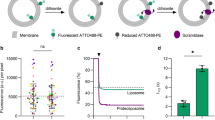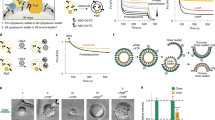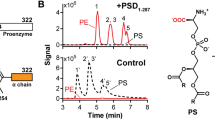Abstract
PROGRESSION of proteins through the secretory pathway of eukaryotic cells involves a continuous rearrangement of macromolecular structures made up of proteins and phospholipids. The protein SEC14p is essential for transport of proteins from the yeast Golgi complex1. Independent characterization of the SEC14 gene2 and the PIT1 gene3, which encodes a phosphatidy-linositol/phosphatidylcholine transfer protein in yeast, indicated that these two genes are identical. Phospholipid transfer proteins are a class of cytosolic proteins that are ubiquitous among eukaryotic cells and are distinguished by their ability to catalyse the exchange of phospholipids between membranesin vitro4. We show here that the SEC14 and PIT1 genes are indeed identical and that the growth phenotype of a sec 14-1ts mutant extends to the inability of its transfer protein to effect phospholipid transfer in vitro4,5. These results therefore establish for the first time an in vivo function for a phospholipid transfer protein, namely a role in the compartment-specific stimulation of protein secretion.
This is a preview of subscription content, access via your institution
Access options
Subscribe to this journal
Receive 51 print issues and online access
$199.00 per year
only $3.90 per issue
Buy this article
- Purchase on Springer Link
- Instant access to full article PDF
Prices may be subject to local taxes which are calculated during checkout
Similar content being viewed by others
References
Novick, P., Field, C. & Schekman, R. Cell 21, 205–215 (1980).
Bankaitis, V. A., Malehorn, D. E., Emr, S. D. & Greene, R. J. Cell Biol. 108, 1271–1281 (1989).
Aitken, J. F., van Heusden, G. P. H., Temkin, M. & Dowhan, W. J. biol. Chem. 265, 4711–4717 (1990).
Wirtz, K. W. A. Biochim. biophys. Acta 344, 95–117 (1974).
Helmkamp, G. M. J. Bioenergetics Biomembranes 18, 71–90 (1986).
Cleves, A. E., Novick, P. J. & Bankaitis, V. A. J. Cell Biol. 109, 2939–2959 (1989).
Franzusoff, A. & Schekman, R. EMBO J. 8, 2695–2702 (1989).
Stevens, T., Esmon, B. & Schekman, R. Cell 30, 439–448 (1982).
Weiland, F. T., Gleason, M. L., Serafini, T. A. & Rothman, J. E. Cell 50, 289–300 (1987).
Hannun, Y. A., Loomis, C. R. & Bell, R. M. J. biol. Chem. 261, 7184–7190 (1986).
Plückthun, A. & Dennis, E. A. J. biol. Chem. 263, 11099–11106 (1988).
Carman, G. M. & Henry, S. A. A. Rev. Biochem. 58, 635–669 (1989).
Lill, R., Dowhan, W. & Wickner, W. Cell 60, 217–280 (1990).
de Vrije, T., de Swart, R. L., Dowhan, W., Tommassen, J. & de Kruijff, B. Nature 334, 173–175 (1988).
Endo, T., Eilers, M. & Schatz, G. J. biol. Chem. 264, 2951–2956 (1989).
Berridge, M. J. A. Rev. Biochem. 56, 159–193 (1987).
Warren, G. Nature 345, 382–383 (1990).
Author information
Authors and Affiliations
Rights and permissions
About this article
Cite this article
Bankaitis, V., Aitken, J., Cleves, A. et al. An essential role for a phospholipid transfer protein in yeast Golgi function. Nature 347, 561–562 (1990). https://doi.org/10.1038/347561a0
Received:
Accepted:
Published:
Issue Date:
DOI: https://doi.org/10.1038/347561a0
This article is cited by
-
Exoproteome analysis of Pseudomonas aeruginosa response to high alkane stress
Archives of Microbiology (2024)
-
Restoration of PITPNA in Type 2 diabetic human islets reverses pancreatic beta-cell dysfunction
Nature Communications (2023)
-
Utilization of n-alkane and roles of lipid transfer proteins in Yarrowia lipolytica
World Journal of Microbiology and Biotechnology (2023)
-
Phylogenetic analysis of plant multi-domain SEC14-like phosphatidylinositol transfer proteins and structure–function properties of PATELLIN2
Plant Molecular Biology (2020)
-
Comparative proteomics reveals the physiological differences between winter tender shoots and spring tender shoots of a novel tea (Camellia sinensis L.) cultivar evergrowing in winter
BMC Plant Biology (2017)
Comments
By submitting a comment you agree to abide by our Terms and Community Guidelines. If you find something abusive or that does not comply with our terms or guidelines please flag it as inappropriate.



